View in other NatureServe Network Field Guides
NatureServe
Montana
Utah
Wyoming
Idaho
Wisconsin
British Columbia
South Carolina
Yukon
California
New York
Asiatic Clam - Corbicula fluminea
State Rank Reason (see State Rank above)
A conservation status rank is not applicable because this species is not a suitable target for conservation activities as a result of being exotic or introduced.
General Description
The Asiatic clam is a small (<60 mm) light-colored (yellow or tan) bivalve with shell ornamented by distinct, concentric sulcations (ridges), anterior and posterior lateral teeth with many fine serrations. Dark shell morphs exist but are limited to the southwestern United States. The shells are very hard and will not break under finger-strength pressure like our native pea-clams will.
Diagnostic Characteristics
A small light-colored bivalve with shell ornamented by distinct, concentric sulcations, anterior and posterior lateral teeth with many fine serrations. Dark shell morphs exist but are limited to the southwestern United States. The light-colored shell morph has a yellow-green to light brown periostracum and white to light blue or light purple nacre while the darker shell morph has a dark olive green to black periostracum and deep royal blue nacre (McMahon 1991). The shells of the yellow morphs were straw yellow on the outside and white on the inside; those of brown morphs were dark brown and purple, respectively. Further analyses revealed that the yellow and brown morphs are triploid and tetraploid, respectively.
The taxonomy of Corbicula species needs further work. Until then, all species of the genus Corbicula collected in the United States are compiled under one name, Corbicula fluminea.
This species could be confused with our native pea-clams, but the Asian clam shells are very hard and will not break under finger-strength pressure like our native pea-clams will.
Range Comments
Native Range: The genus Corbicula lives in temperate to tropical rivers in southern Asia west to the eastern Mediterranean; Africa, except in the Sahara desert; and southeast Asian islands south into central and eastern Australia (Morton 1986).
Nonindigenous Occurrences: The first collection of C. fluminea in the United States occurred in 1938 along the banks of the Columbia River near Knappton, Washington (Counts 1986). Since this first introduction, it is now found in 46 states, the District of Columbia, and Puerto Rico. It has spread to or has secondary introductions into many of the major waterways including the Mississippi and lower Missouri Rivers, Ohio and Tennessee River systems and the Great Lakes. Asian clam (Corbicula fluminea), were first recorded in Lake Tahoe, CA–NV in 2002 and by 2010 nuisance-level population densities (>10,000 per m2) were observed.
This invasive species has only been recently (2019) reported in Lake Elmo near Billings, Montana. The other closest Asian clam populations to Montana have been in Wyoming and Idaho. These clams have been found in the Snake River (ID, WA) of the Columbia River drainages since the late 1990's. In 2011, dead clam specimens were found at several locations along the Laramie River in southeastern Wyoming (2011: B. Bear, personal communication).
For maps and other distributional information on non-native species see:
Nonindigenous Aquatic Species Database from the U.S. Geological Survey
Invasive Species Habitat Tool (INHABIT) from the U.S. Geological Survey
Invasive Species Compendium from the Centre for Agriculture and Bioscience International (CABI)
EDDMapS Species Information EDDMapS Species Information
Observations in Montana Natural Heritage Program Database
Number of Observations: 8
(Click on the following maps and charts to see full sized version)
Map Help and Descriptions
Relative Density
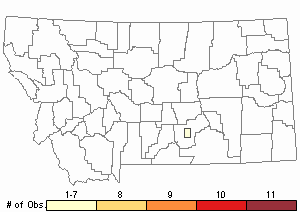
Recency
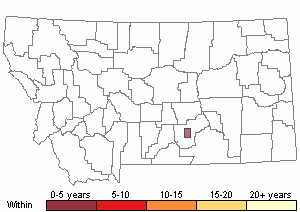
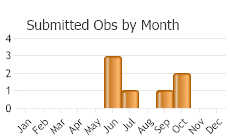
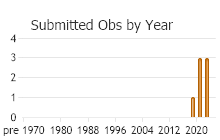
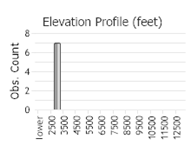 (Observations spanning multiple months or years are excluded from time charts)
(Observations spanning multiple months or years are excluded from time charts)
Migration
This species does not migrate as adults. The Asian clams have a dispersal stage (veligers) that can float in water currents, or adhere to surfaces. The primary means of dispersion of the Asiatic clam is through human transport, by way of water transfer through recreational activities, accidental transfer with imported aquaculture, and intentional introduction to provide a food item.
Habitat
Corbicula fluminea prefers sand or gravel substrates in areas with running water. These filter feeders can be found at the sediment surface or slightly buried beneath (Morton 1986). Widespread throughout freshwater streams, lakes, reserviors and some estuarine habitats in the U.S.
Food Habits
The Asian clam is a filter feeder that removes particles from the water column or within the interstitial spaces in the gravels where they may be buried.
Ecology
It can be found at the sediment surface or slightly buried. Its ability to reproduce rapidly, coupled with low tolerance of cold temperatures (2-30°C), can produce wild swings in population sizes from year to year in northern water bodies. Both yellow and brown morphs are simultaneous hermaphrodites and brood their larvae in the inner demibranchs (Qiu et al. 2001). Furthermore, C. fluminea is able to reproduce by self-fertilization at different ploidy levels. The life span is about one to seven years. C. fluminea is consumed mainly by fish and crayfish. An account of the different species which prey on C. fluminea in the USA is given by McMahon (1983).
Reproductive Characteristics
While self-fertilization occurs, they will also release sperm into the water that can be captured by other clams for fertilization of eggs. One small clam can produce as many as 400 larvae per day or up to 70,000 per year (McMahon 2000). The Asian clam can reach densities of 10,000 to 20,000 clams per square meter in a very short time. The Asian clam is able to reproduce by self-fertilization at different ploidy levels.
Management
Since man has been demonstrated to be the primary agent of dispersal, no large-scale geographic features function as dispersal barriers (Counts 1986, Isom 1986). Current methods of introduction include bait bucket introductions (Counts 1986), accidental introductions associated with imported aquaculture species (Counts 1986). The only other significant dispersal agent is thought to be passive movement via water currents (Isom 1986); fish and birds are not considered to be significant distribution vectors (Counts 1986, Isom 1986).
The most prominent effect of the introduction of the Asian clam into the United States has been biofouling, especially of complex power plant and industrial water systems (Isom et al. 1986; Williams and McMahon 1986). It has also been documented to cause problems in irrigation canals and pipes (Prokopovich and Hebert 1965; Devick 1991) and drinking water supplies (Smith et al. 1979). It also alters benthic substrates (Sickel 1986), and competes with native species for limited resources (Devick 1991). More recent studies have implicated the Asiatic clam with the decline of native mussels for reasons that include: competition for food resources and/or physical habitat space which may result in native mussel displacements (Ferreira-Rodriguez et al 2018).
Contact information for Aquatic Invasive Species personnel:Montana Fish, Wildlife, and Parks Aquatic Invasive Species staffMontana Department of Natural Resources and Conservation's Aquatic Invasive Species Grant ProgramMontana Invasive Species Council (MISC)Upper Columbia Conservation Commission (UC3)Useful Links:Central and Eastern Montana Invasive Species TeamMontana Invasive Species websiteAquatic Invasive SpeciesStewardship Responsibility
Threats or Limiting Factors
Limiting Factors that may affect population density and distribution of Asian clams include excessively high or low temperatures, salinity, drying out, low pH, silt, hypoxia, pollution, bacterial, viral and parasitic infections, inter- and intraspecific competition, predators, and genetic changes
References
- Literature Cited AboveLegend:
 View Online Publication
View Online Publication Counts, C.L., III. 1986. The zoogeography and history of the invasion of the United States by Corbicula fluminea (Bivalvia: Corbiculidae). American Malacological Bulletin, Special Edition No. 2:7-39.
Counts, C.L., III. 1986. The zoogeography and history of the invasion of the United States by Corbicula fluminea (Bivalvia: Corbiculidae). American Malacological Bulletin, Special Edition No. 2:7-39. Devick, W. S. 1991. Patterns of introductions of aquatic organisms to Hawaiian freshwater habitats. Pages 189-213 in New directions in research, management and conservation of Hawaiian freshwater stream ecosystem. Proceedings freshwater stream biology and fisheries management symposium. Department of Land and Natural Resources, Division of Aquatic Resources, Honolulu, Hawaii.
Devick, W. S. 1991. Patterns of introductions of aquatic organisms to Hawaiian freshwater habitats. Pages 189-213 in New directions in research, management and conservation of Hawaiian freshwater stream ecosystem. Proceedings freshwater stream biology and fisheries management symposium. Department of Land and Natural Resources, Division of Aquatic Resources, Honolulu, Hawaii. Isom, B.G. 1986. Historical review of Asiatic Clam (Corbicula) invasion and biofouling of waters and industries in America. American Malacological Bulletin, Special Edition No. 2:1-5
Isom, B.G. 1986. Historical review of Asiatic Clam (Corbicula) invasion and biofouling of waters and industries in America. American Malacological Bulletin, Special Edition No. 2:1-5 Isom, B.G., C.F. Bowman, J.T. Jonson, and E.B. Rodgers. 1986. Controlling Corbicula (Asiatic Clams) in complex power plant and industrial water systems. American Malacological Bulletin, Special Edition No. 2: 95-98.
Isom, B.G., C.F. Bowman, J.T. Jonson, and E.B. Rodgers. 1986. Controlling Corbicula (Asiatic Clams) in complex power plant and industrial water systems. American Malacological Bulletin, Special Edition No. 2: 95-98. McMahon, R. 1991. Mollusca: Bivalvia. pp 315-399 in J.H. Thorp and A.P. Covich (eds.) Ecology and Classification of North American Freshwater Invertebrates. Academic Press, Inc. New York. 911 pp.
McMahon, R. 1991. Mollusca: Bivalvia. pp 315-399 in J.H. Thorp and A.P. Covich (eds.) Ecology and Classification of North American Freshwater Invertebrates. Academic Press, Inc. New York. 911 pp. McMahon, R. F. 1983. Ecology of an invasive pest bivalve, Corbicula. Pages 505-561 in W. D. Russell-Hunter, editor. The Mollusca 6: ecology. Academic Press, Orlando, Florida.
McMahon, R. F. 1983. Ecology of an invasive pest bivalve, Corbicula. Pages 505-561 in W. D. Russell-Hunter, editor. The Mollusca 6: ecology. Academic Press, Orlando, Florida. Morton, B. 1986. Corbicula in Asia - an updated synthesis. American Malacological Bulletin, Special Edition No. 2: 113-124.
Morton, B. 1986. Corbicula in Asia - an updated synthesis. American Malacological Bulletin, Special Edition No. 2: 113-124. Prokopovich, N. P., and D. J. Hebert. 1965. Sedimentation in the Delta-Mendota Canal. Journal of the American Water Works Association 57:375-382.
Prokopovich, N. P., and D. J. Hebert. 1965. Sedimentation in the Delta-Mendota Canal. Journal of the American Water Works Association 57:375-382. Sickel, J. B. 1986. Corbicula population mortalities: factors influencing population control. American Malacological Bulletin Special Edition 2:89-94.
Sickel, J. B. 1986. Corbicula population mortalities: factors influencing population control. American Malacological Bulletin Special Edition 2:89-94. Smith, A. L., A. Mula, J. P. Farkas, and D. O. Bassett. 1979. Clams - a growing threat to inplant water systems. Plant Engineering 1979:165-167.
Smith, A. L., A. Mula, J. P. Farkas, and D. O. Bassett. 1979. Clams - a growing threat to inplant water systems. Plant Engineering 1979:165-167. Williams, C. J., and R. F. McMahon. 1986. Power station entrainment of Corbicula fluminea (Müller) in relation to population dynamics, reproductive cycle and biotic and abiotic variables. American Malacological Bulletin Special Edition No. 2:99-111.
Williams, C. J., and R. F. McMahon. 1986. Power station entrainment of Corbicula fluminea (Müller) in relation to population dynamics, reproductive cycle and biotic and abiotic variables. American Malacological Bulletin Special Edition No. 2:99-111.
- Additional ReferencesLegend:
 View Online Publication
View Online Publication
Do you know of a citation we're missing? Counts, C.L., III. 1991. Corbicula (Bivalvia: Corbiculidae). Tryonia: Miscellaneous Publications of the Department of Malacology, No. 21. The Academy of Natural Sciences of Philadelphia. 134pp.
Counts, C.L., III. 1991. Corbicula (Bivalvia: Corbiculidae). Tryonia: Miscellaneous Publications of the Department of Malacology, No. 21. The Academy of Natural Sciences of Philadelphia. 134pp. McMahon, R. 2000. Invasive characteristics of the freshwater bivalve Corbicula fluminea. pp 315-343 In R. Claudi and J. Leach (eds.) Nonindigenous Freshwater Organisms: Vectors, Biology and Impacts. Lewis Publishers. Boca Raton, FL.
McMahon, R. 2000. Invasive characteristics of the freshwater bivalve Corbicula fluminea. pp 315-343 In R. Claudi and J. Leach (eds.) Nonindigenous Freshwater Organisms: Vectors, Biology and Impacts. Lewis Publishers. Boca Raton, FL.
- Web Search Engines for Articles on "Asiatic Clam"
- Additional Sources of Information Related to "Mussels / Clams"





